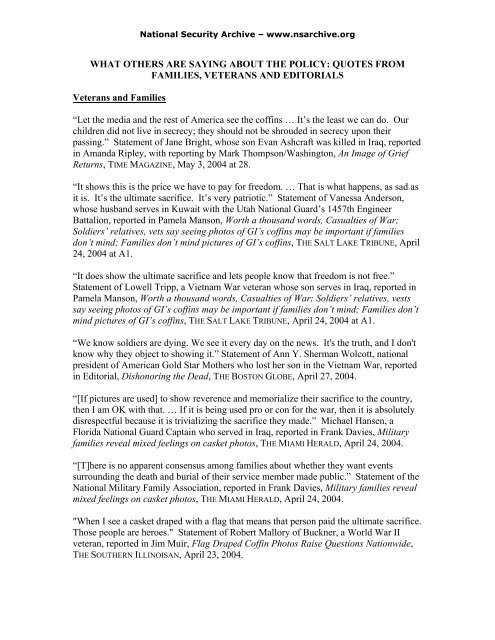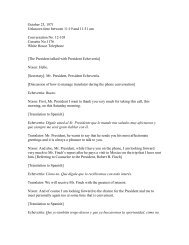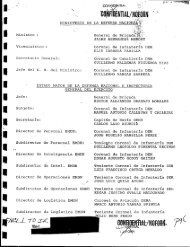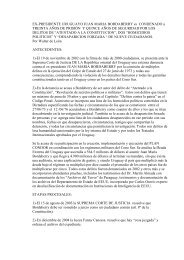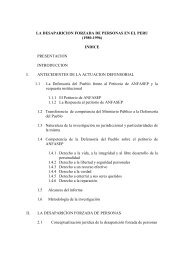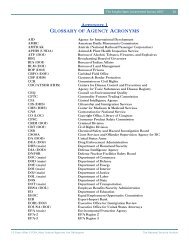What Others Are Saying About the Policy - The George Washington ...
What Others Are Saying About the Policy - The George Washington ...
What Others Are Saying About the Policy - The George Washington ...
You also want an ePaper? Increase the reach of your titles
YUMPU automatically turns print PDFs into web optimized ePapers that Google loves.
National Security Archive – www.nsarchive.orgWHAT OTHERS ARE SAYING ABOUT THE POLICY: QUOTES FROMFAMILIES, VETERANS AND EDITORIALSVeterans and Families“Let <strong>the</strong> media and <strong>the</strong> rest of America see <strong>the</strong> coffins … It’s <strong>the</strong> least we can do. Ourchildren did not live in secrecy; <strong>the</strong>y should not be shrouded in secrecy upon <strong>the</strong>irpassing.” Statement of Jane Bright, whose son Evan Ashcraft was killed in Iraq, reportedin Amanda Ripley, with reporting by Mark Thompson/<strong>Washington</strong>, An Image of GriefReturns, TIME MAGAZINE, May 3, 2004 at 28.“It shows this is <strong>the</strong> price we have to pay for freedom. … That is what happens, as sad asit is. It’s <strong>the</strong> ultimate sacrifice. It’s very patriotic.” Statement of Vanessa Anderson,whose husband serves in Kuwait with <strong>the</strong> Utah National Guard’s 1457th EngineerBattalion, reported in Pamela Manson, Worth a thousand words, Casualties of War;Soldiers’ relatives, vets say seeing photos of GI’s coffins may be important if familiesdon’t mind; Families don’t mind pictures of GI’s coffins, THE SALT LAKE TRIBUNE, April24, 2004 at A1.“It does show <strong>the</strong> ultimate sacrifice and lets people know that freedom is not free.”Statement of Lowell Tripp, a Vietnam War veteran whose son serves in Iraq, reported inPamela Manson, Worth a thousand words, Casualties of War; Soldiers’ relatives, vestssay seeing photos of GI’s coffins may be important if families don’t mind; Families don’tmind pictures of GI’s coffins, THE SALT LAKE TRIBUNE, April 24, 2004 at A1.“We know soldiers are dying. We see it every day on <strong>the</strong> news. It's <strong>the</strong> truth, and I don'tknow why <strong>the</strong>y object to showing it.” Statement of Ann Y. Sherman Wolcott, nationalpresident of American Gold Star Mo<strong>the</strong>rs who lost her son in <strong>the</strong> Vietnam War, reportedin Editorial, Dishonoring <strong>the</strong> Dead, THE BOSTON GLOBE, April 27, 2004.“[If pictures are used] to show reverence and memorialize <strong>the</strong>ir sacrifice to <strong>the</strong> country,<strong>the</strong>n I am OK with that. … If it is being used pro or con for <strong>the</strong> war, <strong>the</strong>n it is absolutelydisrespectful because it is trivializing <strong>the</strong> sacrifice <strong>the</strong>y made.” Michael Hansen, aFlorida National Guard Captain who served in Iraq, reported in Frank Davies, Militaryfamilies reveal mixed feelings on casket photos, THE MIAMI HERALD, April 24, 2004.“[T]here is no apparent consensus among families about whe<strong>the</strong>r <strong>the</strong>y want eventssurrounding <strong>the</strong> death and burial of <strong>the</strong>ir service member made public.” Statement of <strong>the</strong>National Military Family Association, reported in Frank Davies, Military families revealmixed feelings on casket photos, THE MIAMI HERALD, April 24, 2004."When I see a casket draped with a flag that means that person paid <strong>the</strong> ultimate sacrifice.Those people are heroes." Statement of Robert Mallory of Buckner, a World War IIveteran, reported in Jim Muir, Flag Draped Coffin Photos Raise Questions Nationwide,THE SOUTHERN ILLINOISAN, April 23, 2004.
National Security Archive – www.nsarchive.orgOne soldier in Iraq wrote that <strong>the</strong> least <strong>the</strong> nation could do for a soldier that made <strong>the</strong>ultimate sacrifice is to “not hide his body away like something shameful” William M.Arkin, Opinion, Censorship Dishonors <strong>the</strong> Dead—and <strong>the</strong> Truth, L.A. TIMES, May 2,2004 at M3.Editorials“It seems to me that our nation would benefit from both protecting <strong>the</strong> privacy of thosewho grieve and <strong>the</strong> dignity of those who have died and finding a way to invite everyoneto experience common grief. Whe<strong>the</strong>r or not we support <strong>the</strong> way <strong>the</strong> military action inIraq has unfolded, all of us need to be reminded by <strong>the</strong> stark symbols of grief that this is aserious matter in which we are engaged.” Letter of Jin Watkins, a Vietnam War Veteranand escort officer for <strong>the</strong> body of a soldier who died in Vietnam, Voice of <strong>the</strong> People,THE HERALD (Rock Hill, S.C.) May 2, 2004 at 2E.“<strong>The</strong> policy is definitely in conflict with common sense and with a national heritage. <strong>The</strong>military says it maintains its rule to protect <strong>the</strong> privacy of families, but <strong>the</strong> photos showno family names. <strong>The</strong> caskets are as generic as rows of white headstones seen from adistance in Arlington -- and as poignant, for each represents a life taken too soon. Nomatter where one stands on <strong>the</strong> Iraq conflict -- or any of America's wars -- understandingthat human cost is a healthy dose of pain.” Dishonoring <strong>the</strong> Dead, THE BOSTON GLOBE,April 27, 2004.“Images of body bags don’t cause <strong>the</strong> public to question military campaigns. Ra<strong>the</strong>r,questions about <strong>the</strong> rightness of <strong>the</strong> missions feed doubts. A clear eyed assessment of <strong>the</strong>nation’s involvement has a better chance of garnering public support than efforts tosquash legitimate news coverage.” Truth about war casualties, USA TODAY, Oct. 23,2003 at 14A.“It’s fair enough to ask whe<strong>the</strong>r we’ve been too protected from reality, whe<strong>the</strong>rprotecting a family’s privacy is protecting <strong>the</strong> public’s innocence and ignorance. …[H]ow on earth can <strong>the</strong>re be any doubt about showing a sanitized, symbolic array of 20coffins in a plane or dozens in an aircraft hangar during a month when a hundredAmerican are lost? Has our government flunked <strong>the</strong> confidence test?” Ellen Goodman,<strong>The</strong> Pentagon is trying to rig <strong>the</strong> ‘Dover Test’, THE TIMES UNION (Albany, NY), April30, 2004 at A13.“Pictures of caskets and body bags remain as some of <strong>the</strong> most powerful images of ourpast wars. Seeing coffins draped in American flags brings home <strong>the</strong> cost of <strong>the</strong> Iraqisituation more than any article in <strong>the</strong> New York Times ever will. By not allowing <strong>the</strong>public to see <strong>the</strong>se pictures, <strong>the</strong> military is practicing a form of censorship that isinsidious and even unpatriotic.” Editorial Board, End <strong>the</strong> ban on war pictures, THETEMPLE NEWS (Temple University, Philadelphia, PA), October 30, 2003.“Under <strong>the</strong> Pentagon clamp down, American fatalities will be reduced to statistics, and<strong>the</strong> public will see little of <strong>the</strong> human side of <strong>the</strong> war. … But <strong>the</strong> families of <strong>the</strong> fallenAmericans should not have to grieve alone. We can only share by knowing.” Helen
National Security Archive – www.nsarchive.orgThomas, <strong>The</strong> families of fallen U.S. soldiers should not grieve alone, THE MIAMIHERALD, October 31, 2003.“<strong>The</strong>se are not gory images. <strong>The</strong>y are closed coffins, carefully shrouded in crispAmerican flags. Viewers of <strong>the</strong> photos cannot determine whose body lies inside. Nogrieving family members are present for <strong>the</strong> camera lens to exploit. <strong>The</strong> only people in<strong>the</strong> photos are o<strong>the</strong>r members of <strong>the</strong> military, solemnly carrying <strong>the</strong> coffins or offeringsalutes of honor.” Mary Sanchez, A tug of war over images of <strong>the</strong> fallen; Respect forlosses should trump photo ban, THE KANSAS CITY STAR, April 27, 2004 at B7.PollsA New York Times/CBS News poll taken in December 2003 found that 62 percent ofAmericans said <strong>the</strong> public should be allowed to see pictures of <strong>the</strong> military honor guardreceiving caskets of soldiers killed in Iraq as <strong>the</strong>y are returned to <strong>the</strong> United States.Twenty-seven percent said <strong>the</strong> public should not be allowed to see those ceremonies.<strong>The</strong> results are available at:http://www.nytimes.com/2004/04/29/politics/29POLL.html?ex=1094011200&en=6ecfb742febed7ad&ei=5070


